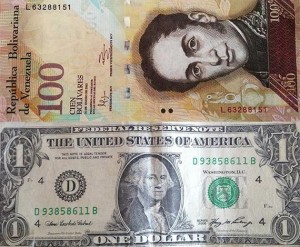Three Markets for a Weakening Venezuelan Bolivar
Last Wednesday, the Central Bank of Venezuela agreed on a new exchange rate system that would reactivate free market cash exchange operations after more than a decade of being abolished. The new system “Simadi” (Marginal System for Foreign Exchange) stipulates that the government will keep an exchange rate of 6.3 Bolívares to the dollar for “official imports” of basic consumption goods and 12 Bolívares to the dollar for auction markets. All other transactions’ exchange rate will be left to the free market, including bank currency purchaces and international credit cards. While this measure allows transactions on the free market exchange rate, the system’s three-part exchange rate suggests that this is a tool Maduro and his government are using to merely disguise the exorbitant devaluation of the Venezuelan currency. According to Central Bank figures, the price for the Bolívar in the free market could be quoted at around 125-140 bolivars the dollar, which would implicate a 95% devaluation from the official exchange. Venezuelan bonds’ price fell significantly after the press conference on the new exchange rate system; investors were disappointed and expected a more simplified and transparent foreign exchange system that honestly confirmed the devaluation of the Bolívar. As a result, the Venezuelan government now faces a 24% risk premium when seeking credit.
Moreover, through the Simadi, there is a limit to how many Bolívares Venezuelans can exchange: they can buy up to $300 a day, up to $2000 a month, and up to $10,000 a year. While Henrique Capriles, leader of the centrist faction of the opposition and former presidential candidate, criticizes this reform as only a “play on words” to disguise the enormous scarcity of goods in the country and the devaluation of the Bolívar, there are others who claim it will benefit Venezuela. The president of the Central Bank, Nelson Merentes, stated that with the third, free market, there will be a great flow of foreign exchange to the country through remittances and tourism.
Capriles, however, is not the only one opposed to president Maduro’s economic policy. Maduro is the successor to the late Hugo Chávez and his policies of “21st century socialism,” which included the abolishing of the free exchange rate market and the nationalization of over 1200 companies. While oil revenues sustained Chávez’s expenses, Maduro’s administration is now seeing a fiscal debt of nearly 20% GDP, in part due to the various subsidies that Chávez established, and the plummeting of oil prices. Víctor Álvarez, Chávez’s industry minister in 2005-06, is arguing for a decrease in government spending through subsidies and cheap-oil foreign aid, as well as a unification of the exchange rate and a freer rein on the private sector. Both Maduro’s political supporters and opponents recognize the unsustainability of economic policies like the new exchange rate system.
Apart from the rampant opportunities for arbitrage and emergence of black markets, the new 3-part exchange rate system implies an even bleaker outlook for Venezuelans, as their Bolívares are buying less and less dollars. After Chávez’s nationalized a range of industries and pushed most of them to the verge of collapse, many consumer goods formerly produced domestically must now be imported. With the devaluation of the currency, a free market exchange rate leaves the Bolívar with a smaller purchasing power, and Venezuelans dependent on the government’s promises to supply basic goods. Experts claim this will be the year when Maduro will have to face a choice: either default on the government’s already exorbitant debt, or allow the Bolivar to fall while import prices rise, to the misfortune of Venezuelans.

